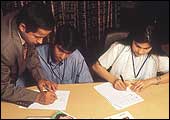 |
| India Action Plan's CEO Vipul Kant Upadhyay
(third from left) and his 100 employees have learned the basics
of the Japanese way |
It's
difficult to say you were late for work because you didn't know
how to sort the garbage. But it did happen to Piyush Sinha. He was
just out the front door of his hired Tokyo apartment when he saw
the garbage bags at his front door.
Sinha, 25, a dapper database consultant from
Delhi, was taken aback. If garbage bags (gomi in Japanese) were
sent back to your door from the kerbside in a city that worked with
clockwork precision, something was amiss. Sinha called in his interpreter.
After a discussion with the landlord it transpired that since Sinha
had not sorted out his garbage in five bags-to be put out on five
different days-as required, the piqued landlord had dumped them
back.
Everything about Japan-from garbage habits
to business meetings-is hugely different from the US, the one foreign
country that Indians in infotech use as a benchmark. But as growth
rates fall, the call of high-tech Japan is strong. With names like
Mitsubishi, Sony, and Toyota among the giants with it needs, the
estimated it spend in Japan is projected to reach $54 billion (Rs
2,63,520 crore) within the next two years. Japan's spend on it services
is today about 15 per cent of the world market. "The combination
of Japanese hardware skills and Indian software skills can do wonders,"
says Vipul Kant Upadhyay, 27, CEO of India Action Plan (IAP), a
Delhi software start-up that Sinha, who was flustered by Tokyo garbage,
works for.
While Japan is the third largest export destination
for Indian software, it accounts for a piffling Rs 1,000 crore of
the total exports of Rs 63,000 crore. "Indian exports to Japan
can definitely grow, especially in areas like telecom-related software,
embedded software, chip design, and enterprise application integration,"
notes Sunil Mehta, VP (Research) at the National Association of
Software and Service Companies (NASSCOM).
To Indians raised on chaos and imprecision,
though, the nuanced, ritualistic Japanese way of life and doing
business is a shock-and a fear factor. Add on high costs from real-estate,
living and the need to hire consultants and interpreters; rigid,
hierarchical companies; and testing decision-making processes. Japan
scares Indian it.
But IAP is showing how the Japanese market
can be cracked. In the 18 months of its existence, the start-up
has registered revenues of $3 million (Rs 14.4 crore) and is one
of India's top performers in the land of the rising sun. With its
formidable Japanese expertise, IAP is now the lead adviser to a
consortium of 37 Indian software companies that have just ventured
into Japan.
First lesson: there are no shortcuts. The language
and the culture must be mastered before doing business.
 |
| Body Language: Employees
learn business rituals, like exchanging cards. Hint: you must
take it with both hands. |
 |
| Table Manners: Learning
to eat with chop-sticks and drinking sake right is a must. Deals
are often closed after-hours. |
 |
| Mastering Japanese: Refresher
courses tech the kanji script, one of three varieties used in
writing and software development |
The U.S. Of A This Ain't
"Ohayou gozaimasu!"
"Hazime mashite!"
The otherwise dour Haryanvi guards at the door
of IAP's office now greet visitors with a cheery, if guttural "good
morning" and "how are you" in Japanese. Inside, the
immersion in Japanese culture continues. The entire office is carpeted
and the staff wear surippa (slippers) to get a feel of Japanese
office environments. When employees talk to one another, you will
hear many a Vinod san or Ashok san. Rewards include lunches-in Japanese
restaurants. Fluency with chopsticks is a must too, and employees
use coffee beans for chopsticks practice in office, then go to a
restaurant to polish those skills.
The effort goes beyond the superficial. It
starts with the recruitment process. IAP hires only one in 200 applicants,
focusing on those who are, or might be, comfortable in Japanese,
or a Japanese environment at least. With the management's unrelenting
efforts, almost all of the 110 employees can exchange at least basic
civilities in Japanese. More importantly, a fourth of the total
workforce is now fluent in Japanese, including top management.
Still, there is always much to learn.
Staffers are made aware of the nuances of what
might seem a simple introduction.
For instance, it's customary to bow when formally
introduced, but the depth and length of the bow indicates respect.
That's a far cry from an enthusiastic handshake. The US this ain't.
Similarly, exchanging cards is a ritual (present
it with both hands, take a moment to study it before shaking hands,
then place it in front of you for reference and an additional sign
of respect). "It's a unique working culture and cannot be learned
through books," says Ashok Kumar Gupta, 28, a team coordinator.
So video sessions on social interaction are routine.
Then come the nitty-gritties of software work.
It's vital to know Japanese, a complicated language for Indian programmers
with its three scripts, all often appearing in the same sentence.
Software project specifications are entirely in Japanese. Interpreters
don't always work. "Using an interpreter to translate sometimes
leads to a situation where 'disconnect from database' gets translated
as 'amputate from database','' says Ashish Dange, 28, a business
manager.
Most Indian companies looking for short-term
gains simply don't have the patience and long-term planning required
to make the grade in the Japanese market. Picking up people, giving
them some language training and packing them off for a few months
to Japan achieves nothing-except maybe a polite sayonara.
|
TREADMILL
|
| Da Deadlift
There is something basic and
primitive about the old-fashioned deadlift that appeals to
me. It is its utter lack of effeteness that I find attractive.
Strangely, there's also an exclusivity about deadlifts. Nouveau
gym rats, bred on the handles and pulleys of lat machines,
don't normally do the deadlift. And your average NewGen trainers,
with gelled hair and muscle Ts won't tell you about it. Unless
you ask. That's when their eyes grow alive as if to say: ''Finally,
here's a serious hard body!'' Because every self-respecting
gym instructor does deadlifts. Those who don't, shouldn't
really be instructing anybody!
What's so great about this very, very basic, two-movement
exercise? For one, it builds more than just muscle. It builds
strength-in the lower and middle section of the back, hamstrings,
shoulders and even the arms. It trains just about every pulling
muscle from head to toe.
I'll try and describe to you what the perfect deadlifting
technique should be like. Stand in front of a barbell, with
feet apart at shoulder width; hold the bar with overhand grips,
hands just outside your legs; you should be looking straight
ahead with your chest up and shoulder blades back. This is
the starting position. Now, you push down with your heels
as you stand up; don't flex your arms, just stand up. That's
movement two. Repeat. Do three sets of 10 reps and keep increasing
the weights for each set.
Simple, yes, but deadlifts are serious stuff. A common mistake
while deadlifting-and one that can cause serious lower-back
injuries (by the way, if you have lower-back ailments, avoid
deadlifts like a diabetic would sugar)-is to hold the bar
as close to your body as you can. Bringing the weight up too
far away from the body can cause injuries. Tip: before starting
the lift, let the bar touch your shins and while standing
up, try to keep it in contact with your legs. Yes, I know,
you're likely to scrape your shins. But scraped shins or a
bad lower back? You decide.
As you get addicted to the deadlift, you could try variants:
mixed grips, for instance, where one hand grips the bar in
an overhand fashion and the other in an underhand fashion.
But remember to swap grips for alternate sets so that that
muscles develop uniformly on either sides of the body. There
are other more advanced variants like the stiff-legged deadlift
or the snatch gripped deadlift. Snatch grip? That's when you
hold the bar much wider... say, 5-6 inches away from each
of your legs. But more on grips later.
Muscles Mani
|
|

